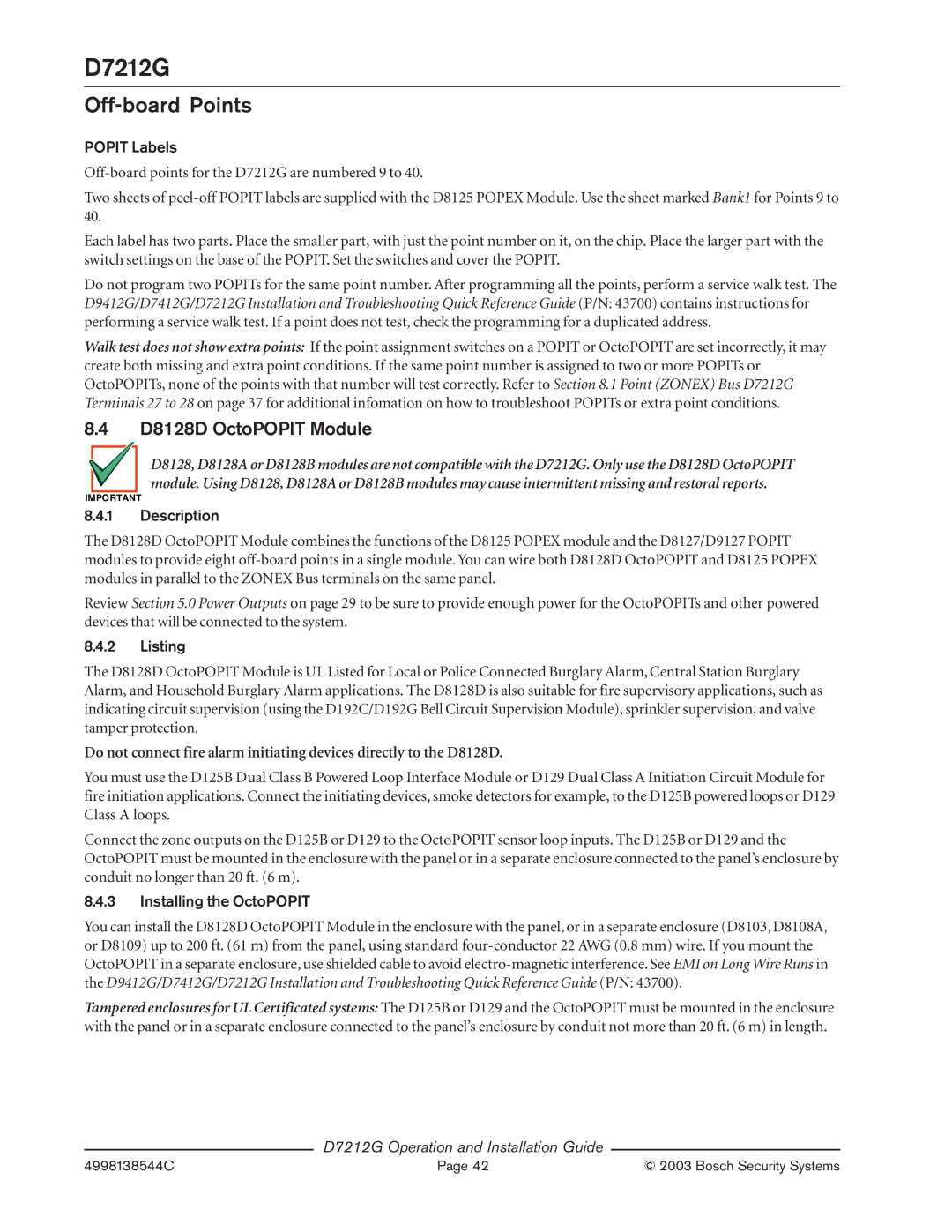
D7212G
Off-board Points
POPIT Labels
Two sheets of
Each label has two parts. Place the smaller part, with just the point number on it, on the chip. Place the larger part with the switch settings on the base of the POPIT. Set the switches and cover the POPIT.
Do not program two POPITs for the same point number. After programming all the points, perform a service walk test. The D9412G/D7412G/D7212G Installation and Troubleshooting Quick Reference Guide (P/N: 43700) contains instructions for performing a service walk test. If a point does not test, check the programming for a duplicated address.
Walk test does not show extra points: If the point assignment switches on a POPIT or OctoPOPIT are set incorrectly, it may create both missing and extra point conditions. If the same point number is assigned to two or more POPITs or OctoPOPITs, none of the points with that number will test correctly. Refer to Section 8.1 Point (ZONEX) Bus D7212G Terminals 27 to 28 on page 37 for additional infomation on how to troubleshoot POPITs or extra point conditions.
8.4D8128D OctoPOPIT Module
D8128, D8128A or D8128B modules are not compatible with the D7212G. Only use the D8128D OctoPOPIT module. Using D8128, D8128A or D8128B modules may cause intermittent missing and restoral reports.
IMPORTANT
8.4.1Description
The D8128D OctoPOPIT Module combines the functions of the D8125 POPEX module and the D8127/D9127 POPIT modules to provide eight
Review Section 5.0 Power Outputs on page 29 to be sure to provide enough power for the OctoPOPITs and other powered devices that will be connected to the system.
8.4.2Listing
The D8128D OctoPOPIT Module is UL Listed for Local or Police Connected Burglary Alarm, Central Station Burglary Alarm, and Household Burglary Alarm applications. The D8128D is also suitable for fire supervisory applications, such as indicating circuit supervision (using the D192C/D192G Bell Circuit Supervision Module), sprinkler supervision, and valve tamper protection.
Do not connect fire alarm initiating devices directly to the D8128D.
You must use the D125B Dual Class B Powered Loop Interface Module or D129 Dual Class A Initiation Circuit Module for fire initiation applications. Connect the initiating devices, smoke detectors for example, to the D125B powered loops or D129 Class A loops.
Connect the zone outputs on the D125B or D129 to the OctoPOPIT sensor loop inputs. The D125B or D129 and the OctoPOPIT must be mounted in the enclosure with the panel or in a separate enclosure connected to the panel’s enclosure by conduit no longer than 20 ft. (6 m).
8.4.3Installing the OctoPOPIT
You can install the D8128D OctoPOPIT Module in the enclosure with the panel, or in a separate enclosure (D8103, D8108A, or D8109) up to 200 ft. (61 m) from the panel, using standard
Tampered enclosures for UL Certificated systems: The D125B or D129 and the OctoPOPIT must be mounted in the enclosure with the panel or in a separate enclosure connected to the panel’s enclosure by conduit not more than 20 ft. (6 m) in length.
D7212G Operation and Installation Guide
4998138544C | Page 42 | © 2003 Bosch Security Systems |
